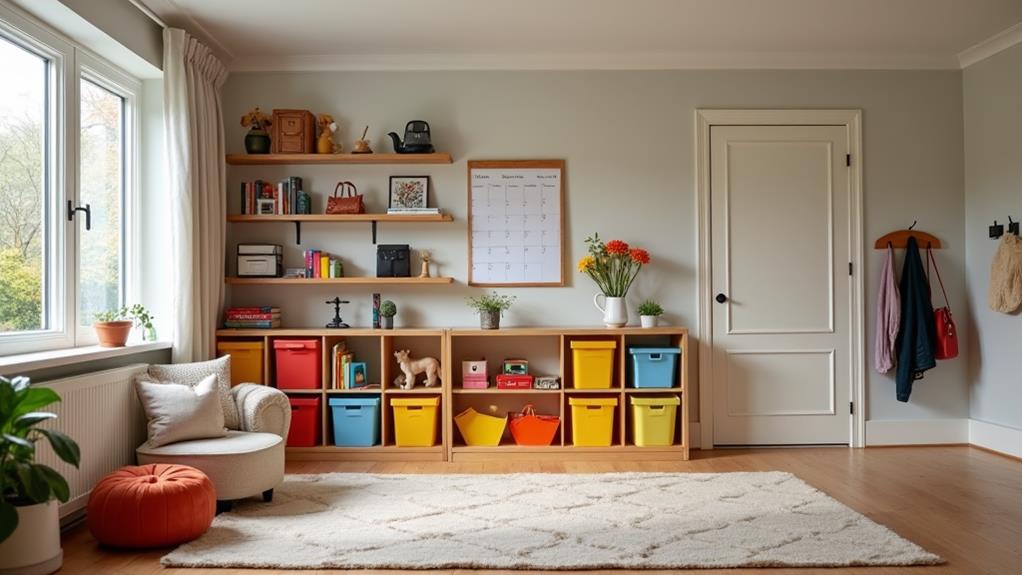To organize your family’s home easily, start by decluttering regularly and involving your kids in the process. Set up designated zones for everyday items like jackets and backpacks to minimize confusion. Use neutral storage bins for a cohesive look, and color-code toys to make clean-up simpler. Create organized spaces in kids’ rooms for toys and homework. Establish a command center for calendars and important documents, and optimize laundry routines with labeled baskets. Develop daily checklists and family meetings to encourage responsibility. Uncover more tips that can make your home organization even easier as you investigate further!
Key Takeaways
- Regularly declutter every six months with the family’s involvement to maintain a clutter-free environment and teach responsibility to children.
- Create designated zones for different activities and use labeled storage bins to promote organization in shared spaces.
- Implement color-coding for family belongings and use neutral storage options to maintain a cohesive and tidy appearance.
- Establish a command center for centralized family organization, including a color-coded calendar and important documents for easy access.
- Develop daily routines with checklists and involve kids to foster responsibility and engagement in home organization efforts.
Declutter Regularly
When it comes to keeping your home organized, regular decluttering is essential. For large families, this process can seem intimidating, but breaking it down makes it manageable. Start by evaluating and cleaning out closets every six months. This helps you manage outgrown items and guarantees only necessary belongings stay.
To streamline the decluttering process, sort items into three categories: donate, trash, and keep. This method not only simplifies decisions but also nurtures a sense of responsibility among family members. Involve your children in this process; teaching them the importance of maintaining a clutter-free environment sets them up for future success.
Consider conducting seasonal decluttering, rotating out clothing and toys to adapt to changing needs. This keeps only what’s relevant and avoids overwhelming clutter.
Create Designated Zones
Creating designated zones in your home can greatly enhance organization and reduce clutter. For large family organization, it’s essential to establish specific areas for various activities. Consider setting up a drop zone near the entrance for jackets and backpacks, a reading nook for books, and a craft corner for art supplies. This not only promotes organization but also makes materials easily accessible.
To make the most of your designated zones, use labeled storage bins or baskets. This encourages family members, especially children, to return items to their proper places, cultivating a sense of responsibility. Additionally, color-coding zones for each family member can enhance personal accountability and simplify tracking belongings in shared spaces.
Here’s a quick reference table to help you visualize potential zones:
| Zone Type | Purpose |
|---|---|
| Drop Zone | Store jackets, bags, and shoes |
| Reading Nook | Keep books and reading materials accessible |
| Craft Corner | Organize art supplies and projects |
| Game Area | House board games and recreational items |
Regularly reassess these zones to adapt to your family’s changing needs, ensuring your organization system remains effective.
Use Neutral Colors

Maintaining organized zones is just the beginning; the colors you choose for storage can make a big difference. Incorporating neutral colors for storage bins and furniture in your kids’ rooms can considerably reduce visual clutter, creating a calmer environment that’s less distracting during play and study times.
Consider these benefits of using neutral colors:
- Cohesive Look: Neutral palettes blend seamlessly with existing decor, enhancing the overall aesthetics of your home.
- Versatile Matching: Neutral storage items easily match various themed toys and accessories, simplifying home organization.
- Ownership: Kids can easily recognize and return items to their designated spots, encouraging them to take responsibility for keeping their rooms clean.
Transitioning to neutral colors not only helps maintain a tidy appearance but also highlights the colorful toys and artwork in your child’s room.
This way, lively elements stand out as focal points without overwhelming the space. By choosing neutral tones for storage solutions, you can create an organized, visually appealing environment that encourages kids to enjoy their space while keeping their rooms clean and tidy.
Implement Toy Storage Solutions
Implementing effective toy storage solutions can convert chaotic play areas into organized spaces. Start by designating specific storage spots for each toy, ensuring every item has a place. This promotes organization and accountability among your children.
Employ labeled bins or baskets to categorize toys by type. This makes it easier for your kids to find and return items after playtime.
Consider implementing a rotation system for toys, keeping only a selection accessible at a time. This reduces clutter and encourages imaginative play.
Regularly encourage your children to participate in decluttering sessions. This helps them evaluate which toys to keep, donate, or discard, nurturing a sense of responsibility.
When selecting storage solutions, opt for neutral colors. This choice minimizes visual clutter and creates a calmer environment amid colorful toys.
With these strategies, you’ll not only keep things organized but also teach your children important lessons about responsibility and care for their belongings.
Organize Kids’ Rooms Efficiently
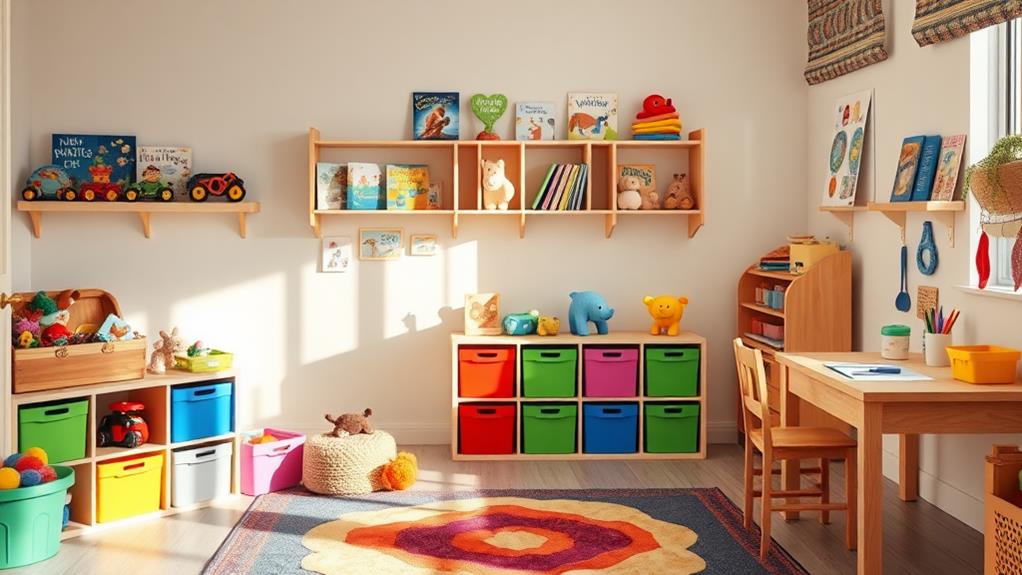
An organized kids’ room can make a significant difference in your child’s daily routine and overall well-being. By implementing a few straightforward strategies, you can help your child take ownership of their space and cultivate a sense of responsibility.
- Designate Areas: Set specific spots for toys, books, and games, making it easier for your child to find and return items.
- Color-Coded Storage: Use different colored bins to help your child identify where items belong, promoting accountability in keeping their room tidy.
- Regular Decluttering: Schedule a decluttering session every few months to assess and remove outgrown or unused items, maximizing usable space.
Additionally, create a designated homework station with necessary supplies. This dedicated area can enhance focus and productivity during study time.
Encourage your child to respect shared spaces by providing them with their own area for personal belongings.
Establish a Command Center
Creating a command center can change how your family manages daily activities and responsibilities. By designating a specific area in your home, like a wall or a bulletin board, you centralize your family’s organization.
Incorporate a monthly calendar that’s color-coded for each family member, making it easy to track schedules and events at a glance. Within this command center, post important documents, notifications, and family goals for quick access.
Use labeled bins and hooks to store essential items like keys, bags, and school supplies, guaranteeing everything has a designated spot. This keeps your space tidy and stress-free.
To maintain engagement, regularly update the command center to reflect any changes in schedules. This guarantees all family members stay informed and accountable for their responsibilities.
Additionally, incorporate visual cues like chore charts and weekly meal plans to encourage teamwork and organization.
Color-Code Family Belongings
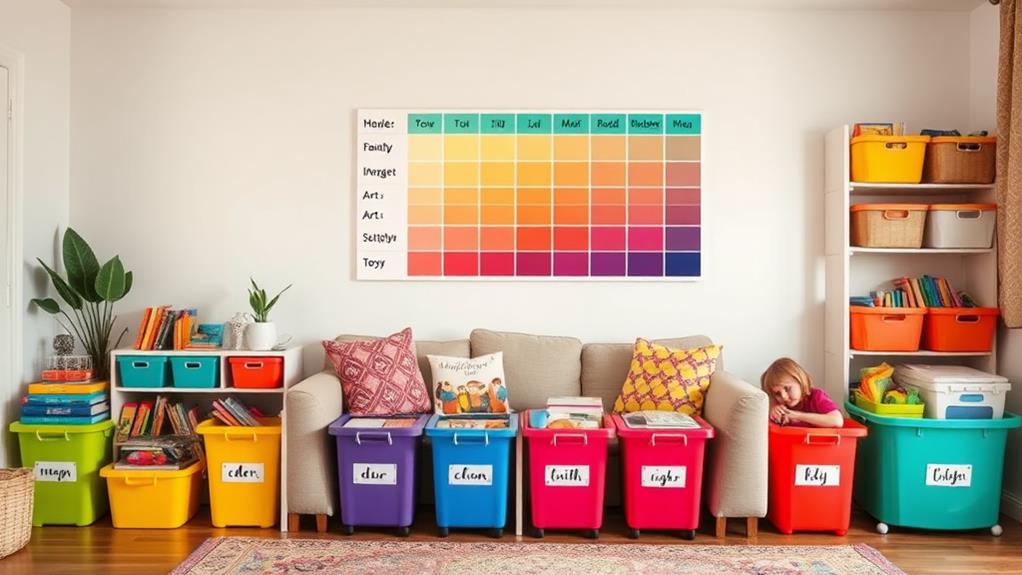
Color-coding family belongings is a simple yet effective way to keep your home organized and help everyone stay responsible for their items. By assigning a specific color to each family member, you can easily identify and track personal belongings throughout your home. This method not only simplifies access but also nurtures a sense of ownership among children.
Here are some practical ways to implement color-coding:
- Use color-coded bins for toys, making clean-up easier.
- Label school supplies with each family member’s color to avoid mix-ups.
- Create a visual system for shared spaces, like colored hooks for jackets and bags.
Encouraging children to choose their favorite colors for their storage solutions instills satisfaction in maintaining an organized space.
Additionally, be sure to regularly review and update the color-coding system to accommodate any changes in family members or items. This vigilance helps streamline your family’s organization efforts, complementing other activities like meal planning.
With a little creativity and consistency, color-coding can alter the way you manage your family’s belongings, making it a breeze to keep everything in order.
Streamline Meal Planning
Streamlining meal planning can save your family an average of 2-3 hours each week, making grocery shopping and cooking much less stressful. With three kids, it’s crucial to create a system that works for everyone. Start by planning your meals for the week ahead, focusing on a balance of proteins and vegetables to cater to diverse preferences.
Involve your kids in the meal prep process; it teaches them useful skills while cultivating healthy eating habits and family bonding. Batch cooking staple ingredients like grains and proteins can also help minimize daily cooking times.
To keep your meals organized, consider the following table:
| Meal Planning Tips | Benefits |
|---|---|
| Plan meals weekly | Saves time and reduces stress |
| Involve kids | Teaches skills and encourages bonding |
| Batch cook staples | Quick meals throughout the week |
| Use portioned containers | Simplifies reheating and tracking freshness |
| Incorporate variety | Guarantees balance and keeps meals interesting |
Schedule Family Meetings
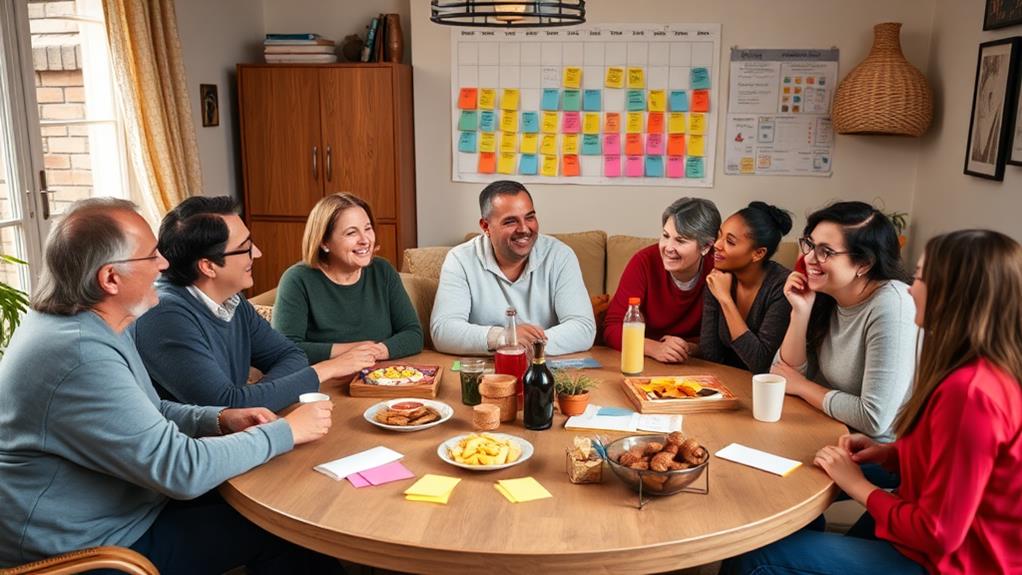
Once you’ve gotten your meal planning under control, it’s time to focus on another key aspect of family organization: scheduling regular family meetings. These gatherings, which should ideally happen weekly or biweekly, help keep everyone informed about upcoming events, responsibilities, and any issues that may arise.
Here are a few tips to make the most of your family meetings:
- Use a digital calendar: Review schedules and deadlines together, allowing everyone to visualize their commitments.
- Encourage open communication: Create a safe space for family members to share thoughts, concerns, or suggestions regarding household organization.
- Assign specific roles or tasks: Promote accountability by encouraging everyone, including children, to take ownership of their responsibilities.
Utilizing family meetings also allows you to celebrate achievements and review progress on organizational goals. This not only strengthens family bonds but also makes necessary adjustments to improve interactions and efficiency.
Optimize Laundry Organization
Managing laundry can feel like a never-ending chore for many families, but optimizing your laundry organization can simplify the process greatly. Start by separating laundry by each member of the family or by type, using labeled baskets. This makes sorting easy and encourages everyone to pitch in.
For older children, designate specific laundry days to promote responsibility and independence in managing their own clothing.
Implement a color-coding system for the laundry baskets to help younger kids quickly identify whose clothes belong where. This small change can greatly simplify the sorting process and make laundry feel less overwhelming.
Regularly review and declutter your clothing collections, donating or discarding items that are outgrown or no longer worn. This helps maintain an organized laundry space, making it easier to manage.
Develop Daily Routines
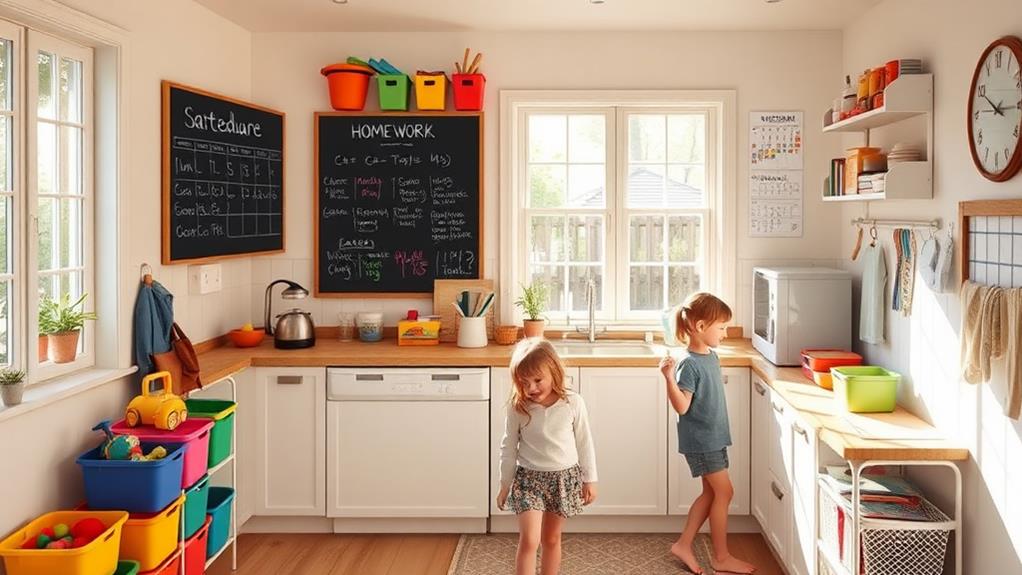
Establishing daily routines can greatly improve your family’s organization and reduce stress. By creating consistent morning and evening rituals, you provide structure that helps both parents and children feel more in control.
Here are some large planning ideas to take into account:
- Implement checklists for daily tasks to help kids take responsibility and guarantee nothing is overlooked.
- Incorporate timers for specific activities to enhance focus and efficiency, so everyone manages their time better.
- Designate family time within your routine to strengthen bonds and promote communication.
Regularly reviewing and adjusting these routines allows your family to stay flexible, addressing changing needs or schedules effectively.
The predictability of established routines can reduce anxiety, making daily life smoother for everyone involved.
Remember, it’s not just about getting tasks done; it’s about creating a positive environment where each family member feels valued and connected.
Involve Kids in Organization
Creating a structured routine lays the groundwork for a more organized home, but it doesn’t stop there. Involving your kids in the organization process is essential. It helps keep them engaged while encouraging a sense of responsibility. Assign specific tasks based on their age—like sorting toys or labeling storage bins—to make sure they find the process enjoyable.
Regularly scheduled decluttering sessions can teach your children significant decision-making skills. They’ll learn how to assess which toys or clothes to keep, donate, or discard. Implementing a color-coding system for each child’s belongings will help them easily identify their items, promoting accountability and organization.
To further motivate your kids, create a fun reward system for successful organization efforts. Whether it’s stickers or a small treat, rewards can encourage them to actively participate in maintaining a clutter-free environment.
Conclusion
By incorporating these easy home organization ideas, you can create a more functional and harmonious living space for your family. Curiously, studies show that organized spaces can reduce stress levels by up to 30%. Regular decluttering, designated zones, and efficient storage solutions not only streamline your home but also encourage a sense of responsibility and teamwork among family members. So, get started today—your organized oasis awaits!
Join our list
Subscribe to our mailing list and get interesting stuff and updates to your email inbox.

